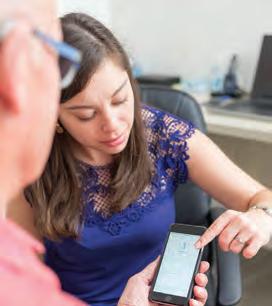
6 minute read
HEALTH
SUPPORT WHEN YOU NEED IT FOR PARKINSON’S DISEASE
NEUROLOGICAL disorders are now the leading source of disability globally, and the fastest growing neurological disorder in the world is Parkinson disease.
Advertisement
Parkinson’s is a progressive neurological condition known as a “motor disorder” and affects more than 18,000 Queenslanders – but it remains one of the least understood.
The average age of diagnosis is 65 years, with 82 per cent at age 65 and over, however younger people are not excluded.
It is not easy to diagnose Parkinson’s. There is no diagnostic blood test or brain scan, so it is important that the diagnosis is made by a specialist, such as a neurologist, who will examine for any physical signs and take a detailed history of symptoms.
The underlying cause relates to a decline in the production of the brain chemical, dopamine. This lack of dopamine causes difficulty in controlling movements and moving freely.
Non-motor symptoms such as pain, depression and problems with memory and sleep can also occur and have an impact on day-to-day life.
There is currently no known cure.
However, there are many treatments available that can allow a person with Parkinson’s to lead a fulfilling and productive life. Treatments can assist in managing symptoms and provide a high quality of life for years to come.
Parkinson’s Queensland works to support everyone in Queensland living with Parkinson’s or impacted by the diagnosis and recognises that for each person diagnosed there are up to eight others impacted.
Support ranges from strategic advocacy, partnerships, supporting research and awareness programs, to the education of government and professionals from medical and community sectors.
Individuals are provided with information on various aspects of Parkinson’s diagnosis, educational sessions and webinars.
Most importantly, support groups and telephone peer support programs are available around the state. To find a support group near you, call Parkinson’s Queensland 1800 644 189 or email pqi@ parkinsonsqld.org.au Visit parkinsonsqld.org.au.
KIDNEY fast facts
• Kidneys rid your body of waste (through urine), clean your blood of waste and toxins, regulate your blood pressure and manage the production of
Vitamin D
• The biggest risk factors for kidney disease are diabetes, high blood pressure, established heart problems and/or stroke, family history of kidney failure, smoking, obesity, being 60 years or older.
Check your risk at kidney.org.au/ kidneyrisktest • About 63 people die with kidney-related disease every day • Kidney disease is a silent killer – sufferers can lose 90 per cent
of kidney function without experiencing any symptoms • 1 in 3 people
Australians are at risk of developing chronic kidney disease • 1.7 million Australian adults are affected by kidney disease while 1.5 million of them
are unaware of it • Kidney-related
disease kills more people than breast cancer, prostate cancer and road accidents. GONE are the days of the bulky hearing aids which served only to amplify sound in your ears. ELODIE COMPOS explains the new technology and how to manage it.
Hearing devices now come in small, compact shapes and are loaded with amazing features to improve not only hearing, but also the ease using hearing devices.
There are so many exciting new features and gadgets with hearing aids that it’s easy to feel a bit overwhelmed on what to do and how to do it.
Words such as “Bluetooth”, “streaming”, and “pairing” can sound daunting if you’ve never had to use them, so sometimes some one-on-one tutorial is needed.
Falls of Sound at Indooroopilly offers this assistance with tech support consultations.
A new and exclusive type of hearing health appointment focuses entirely on giving the help needed to get the most out of the technological advances of hearing aids.
That could mean connecting devices, looking at options available or even going over instructions and information one more time. It comes down to what you want to know to feel more “tech-savvy”.
So, what is it you can do with your hearing aids now that’s so special?
Most modern hearing aids are fully Bluetooth compatible, which means you can connect them to your mobile phone and receive phone calls directly to your hearing devices.
You can also listen to music this way, which significantly improves the sound quality and clarity. And you can control the hearing aid volume, microphone directions, sometimes even create or modify special programs for specific noise environments.
Hearing aids are also compatible with extra gadgets to enhance your everyday life.
Small remotes can be used to discreetly change the volume and program of hearing aids. Clip-on external microphones can be connected and used to pick up sound more clearly and from a greater distance which is practical in noisy situations or when listening to a speaker from afar.
For home, there are TV streamers designed to send the sound from the TV program directly into the hearing aids so that you can hear more clearly, and those around you can still watch at their preferred volume.
All of these gadgets and advances are designed to enhance the everyday hearing experience and give you back social confidence. You don’t need a degree in rocket science to make them work, just a bit of a helping nudge from people who work with them every day. Elodie Compos is an audiology assistant at Falls of Sound Hearing Solutions, Indooroopilly. Call 3378 5999 or visit fallsofsound.com.au











